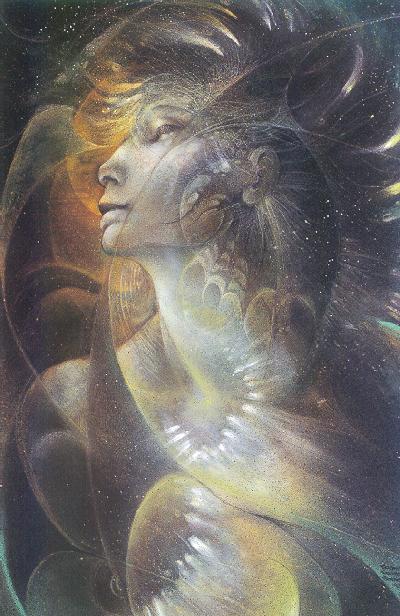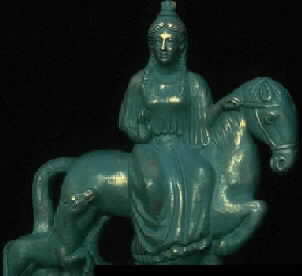|
Epona
THE FRMINIST COMPANIONTO MYTHOLOGY. edited by Larrington, Carolyn. Hammersmith, London. Pandora Press. 1992, 125 -127
Epona is well known to Celtic scholars through her possible connections with the figure of Rhiannon in Pedeir Keinc Y Mabinogi. Her name is associated with the Celtic word for horse. As a goddess, images of her appear in many Celtic contexts, but there are patterns of variation and localization which caution against a too-ready tendency to think of her in pan-Celtic terms.
Epona is always accompanied by a horse, either riding (most common in northern Gaul,
Germany and Burgundy) or in the midst of several horses (mostly in the Rhineland). There was a shrine dedicated to her in Burgundy (Magne and Thevenot, 1953), a region particularly rich in images of the goddess. Here, she is accompanied by a foal eating from an outstretched patera or sleeping under the feet of the goddess's mare. Her role was complex and may in part be contingent on where and when she was worshipped rather than on some overall conception of her function.
Her status as horse-goddess venerated by the Roman cavalry helped spread her cult (Linduff and Oaks in Henig, 1986, pp. 817-37), and is an example of Celtic influence on Roman civilization. Epona was the only Gaulish goddess to be officially honoured in Rome and had her own festival. Some dedications indicate that her devotees were members of cavalry units. Although male gods are associated with horses, and the cavalry was certainly a male domain, the goddess Epona presided over the health and fertility of the animal. She rides side-saddle in a ladylike manner and, to the extent that one can interpret the images in this way, her demeanour is benign. In other words, there is nothing in the imagery which would imply a war- goddess. She holds objects of fertility rather than weapons - a dish from which the foal often feeds, fruit or a cornucopia. Burgundy, the tribal homelands of the Aedui, where the goddess riding side-saddle with a foal is most common, was a centre for horse breeding. The Treveri, centred on Luxembourg, also seem to have favoured the goddess as we can assume from the number of images here. Her importance was certainly linked to that of the horse itself in Celtic society. It has been suggested that her cult, because of her association with horses, was popular among the Gaulish elite, and this in itself would help explain her popularity (Linduff and Oaks in Henig, 1986, pp. 817-37).
Equine associations are not the end of Epona's story. Many images depict her as carrying food, a cornucopia or some object of plenty consistent with her role as benefactress/guardian of horses and probably extending beyond that. Several images have been found in conjunction with therapeutic springs and in one striking instance, she appears as a water-nymph reclining on her mare. The Mediomatrici, centred on Metz, near modern Strasbourg, certainly venerated the horse-goddess, and here she may have functioned as a guardian of the dead. One image shows her on her horse seemingly leading an individual on a journey to the afterlife.
A dedication from Burgundy (Ross, 1967) links her specifically with the mother- goddesses. These may be local adaptations, but with so little evidence and with such ambiguous imagery it is impossible to be too didactic. Epona could have been a horse goddess in origin whose function later became extended to include protection of humans, healing water and guardianship of the dead. On the other hand, the cultural importance of the horse, the prestige of the Roman cavalry and their social importance could have resulted in the equine associations becoming dominant from a wider spectrum of functions. About any myths associated with her, we know nothing, and it is noteworthy that even with such a comparatively well-attested figure as Epona, firm conclusions are impossible.
Epona occurs but rarely in Britain and the best preserved image of her depicts her between two little horses who feed from a dish of food, an image popular in what is now Germany. It is possible that her appearance in Britain is linked to the presence of Roman legionary troops, but she is without doubt a Celtic deity, and we can assume, on the basis of archaeological evidence, that various Celtic tribes venerated a basically benign female deity, associated with horses and possessing, at least in some areas, mother-goddess characteristics directed to humanity. The question then arises, what later material could carry some of these associations? The most obvious is the figure of Rhiannon, the mother of Pryderi who appears in the First and Third Branches of Pedeir Keine Y Mabinogi.
Y Pedeir Keinc comprise the first four tales in a collection of Welsh medieval narratives know collectively as the Mabinogion (Jones and Jones, 1989). These narratives appear quite late in terms of the time-scale we have been considering , after the British Celts had been exposed to Roman, Christian and Anglo-Norman influence and had become Welsh into the bargain. Nevertheless, no one seriously questions the essentially native qualities of the tales or that they reflect to some extent older cultural codes and practices.
Conway, D. J. MAGICK OF the GODS & GODDESSES. St. Paul, Minnesota, Llewellyn Publications, 1997, 223 EPONA-Britain, Gaul. "Divine Horse"; "The Great Mare"; Goddess of horses; Mother Goddess. Fertility, maternity, protectress of horses, horse-breeding, prosperity, dogs, healing springs, crops.
|






